Avon Severn Eel Pass Project
Overview
Work to improve eel passage
Please note this is a project information page. Recent update 21 October 2022. Regular updates were also added to the town council noticeboard on the Ham during construction.
We are complete! Thank you to local residents and visitors for your patience and Jackson Civil Engineering, our contractors.
The Environment Agency has been working to deliver improved eel passage at the confluence between the River Avon and the River Severn.
The main construction works of a new eel pass on the western bank of the River Avon adjacent to the Abbey Mill sluice in Tewkesbury are now completed. Some minor works are ongoing inside the eel pass to ensure it performs exactly as it was designed. (October 2022). This follows works completed in 2021 at Stanchard Pit nearby. The works are required to meet our legal obligation under 12(b) of The Eels (England and Wales) Regulations 2009. These regulations gave the EA new powers to protect the critically endangered eels and to assist their migration past barriers such as weirs and sluices.
Photos below show the progress of the works. Further down this page are: background to the works; information about work at Stanchard Pit and other information we provided prior to works starting. Also: What is special about the Severn Ham and how we are we looking after it during the works?
Construction progress and images
A timelapse video of the work can be viewed here.


September onwards
- Final adjustments within the eel pass to ensure it works to its optimum ability.
- Ongoing reinstatement works for this year before commencing monitoring phase
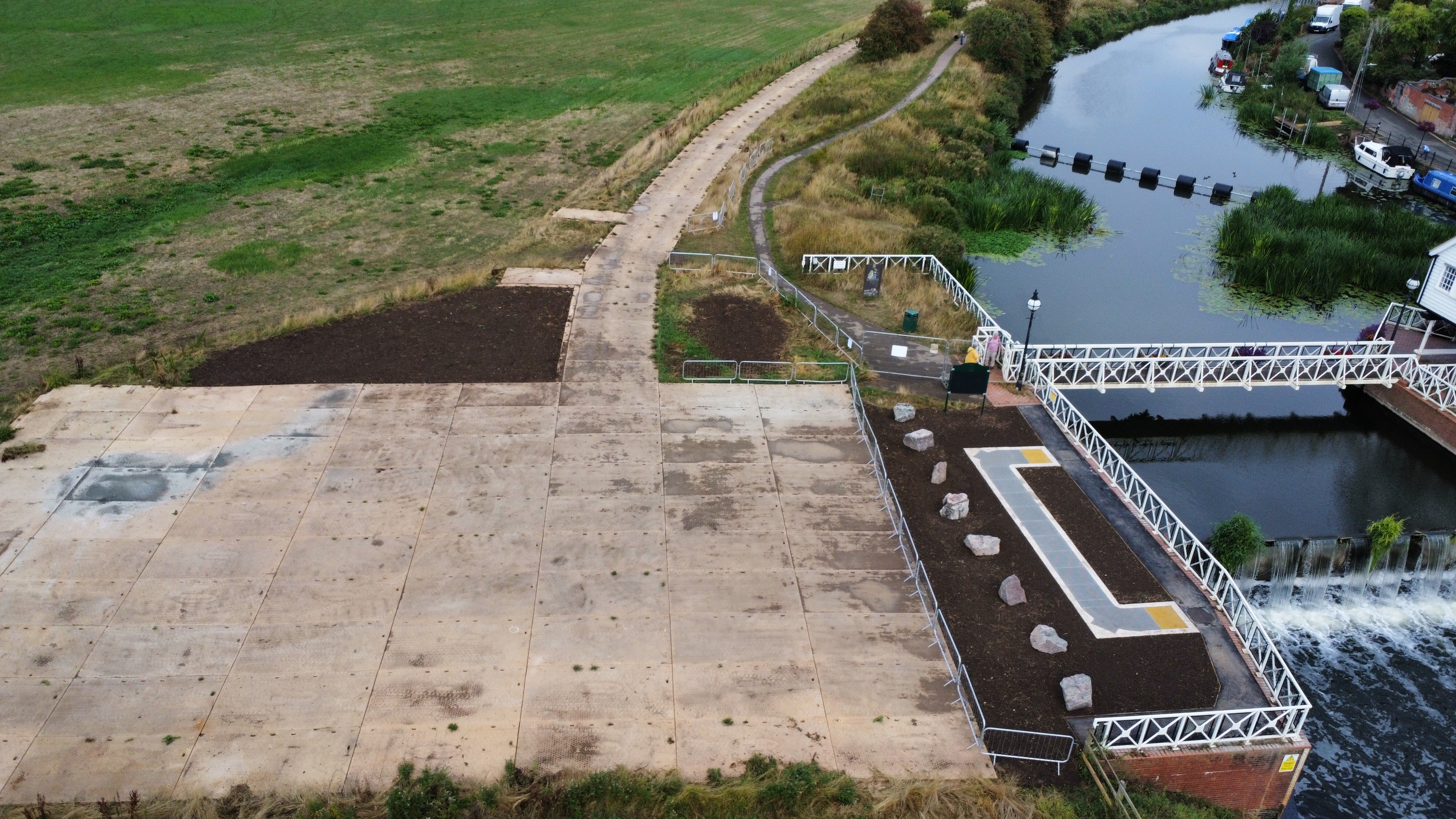

September - August
- Limpet dam was temporarily installed. A small inlet was cut into the wall upstream of the sluice. We created the steel reinforcement and formwork for the upstream chamber and poured concrete to create it.
- Laid the brickwork for the upstream and downstream chamber covers
- Reinstated the tarmac footpath immediately adjacent to the sluice and made preparations for the topsoiling around the eel pass.
- Installation of large blockstones to prevent accidental vehicular damage to the pass.
- Removed the track mats from the work area and access track
- Undertook compaction testing (CBRs) to inform any impact our works have had on the underlying ground of the Severn Ham
- Seeding of the area around the eel pass using the seed mix harvested from the donor site; reinstatement works along access track and work area.
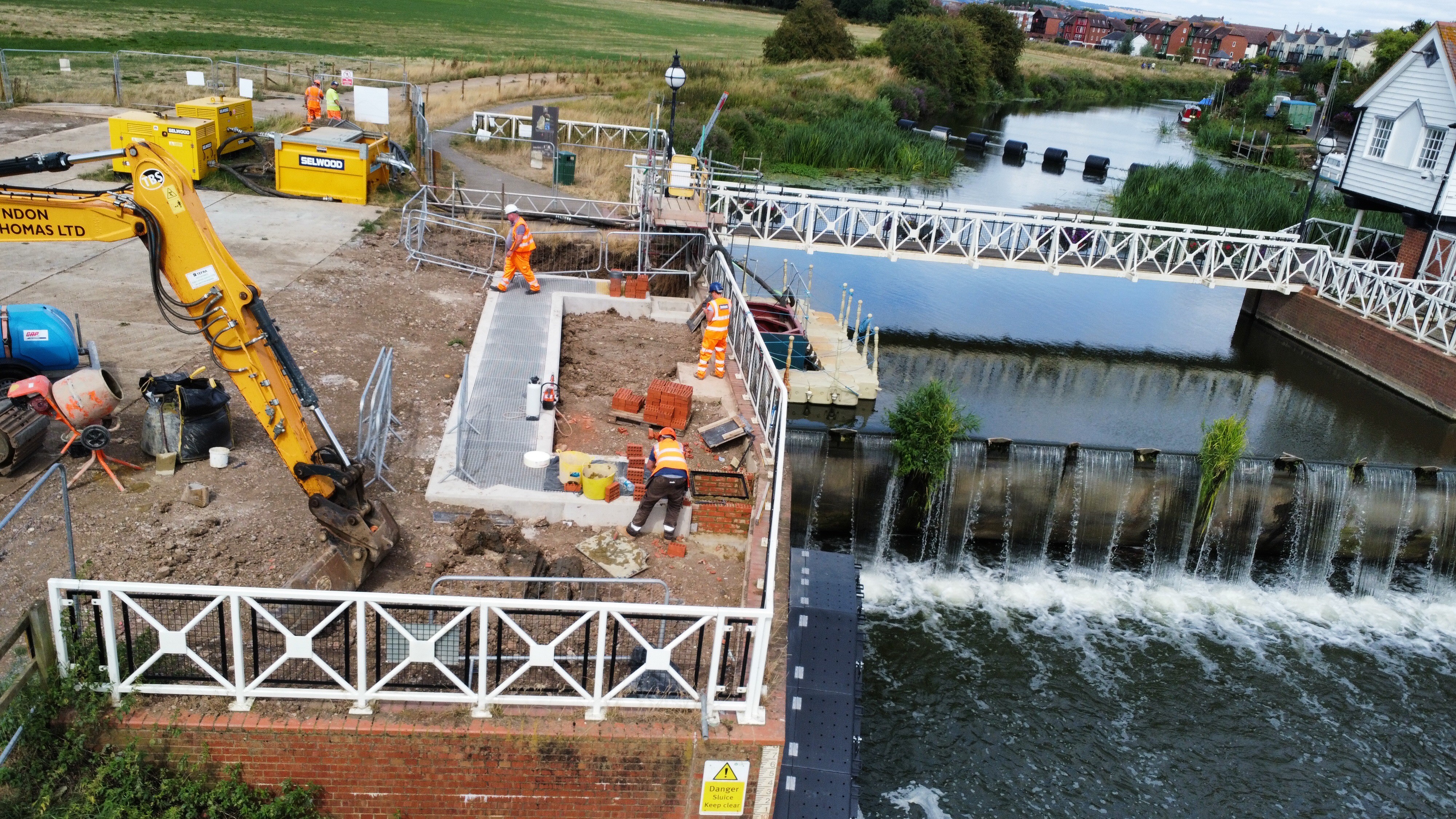

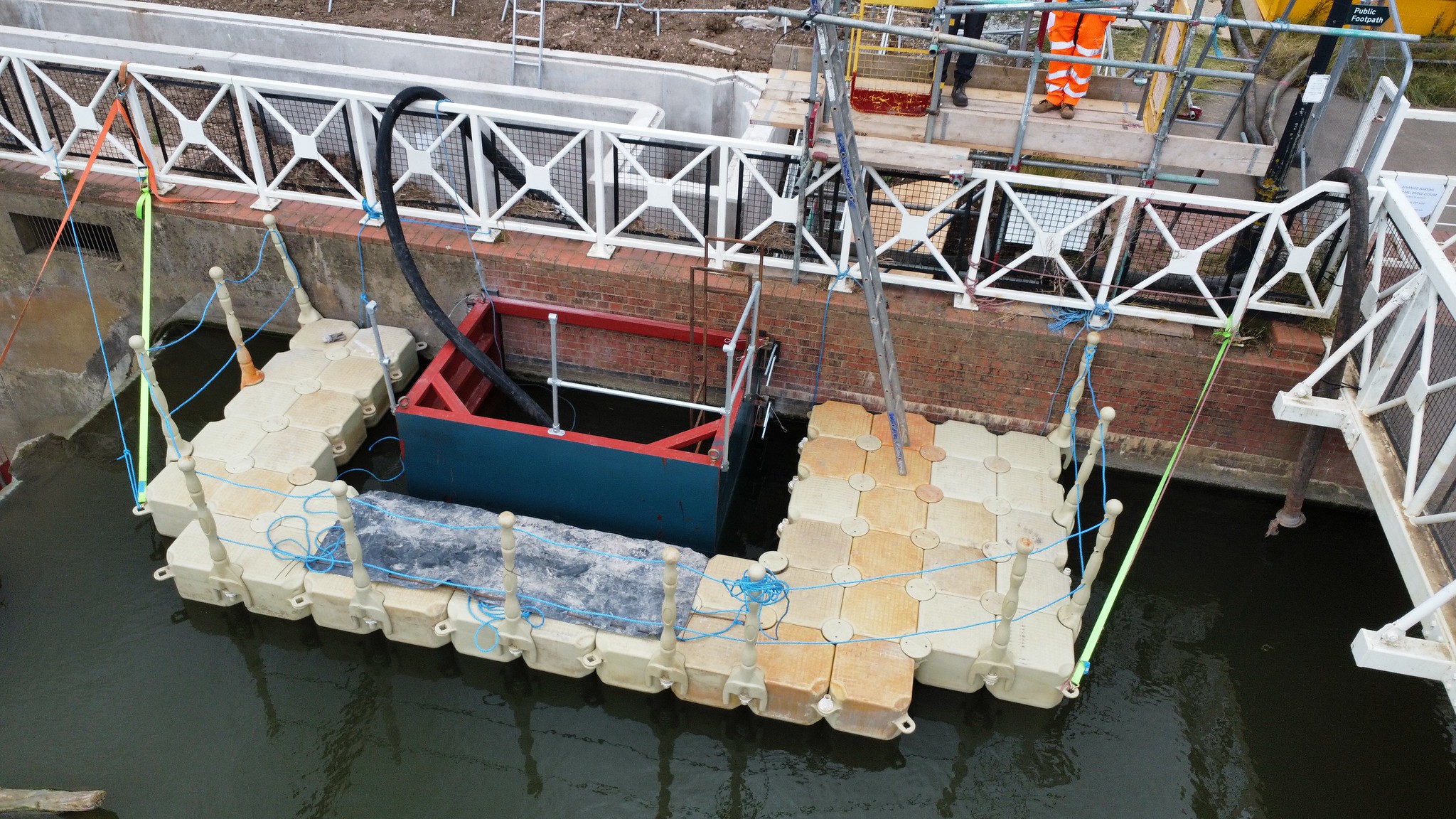
July's activities included:
- Reinforcement and formwork for upstream chamber; pour concrete for upstream chamber walls
- Finishing works within the channel (install the covers, internal finishes) and within the water course (install small rocks at river bank)
- Complete installation of remaining fixings into the wall for the eel pass gantry ramp
- Completing the sealing of the limpet dam to create a water tight area within it.
- Installation of the eel pass tiles within the concrete channel

The eel pass has been lifted into place!
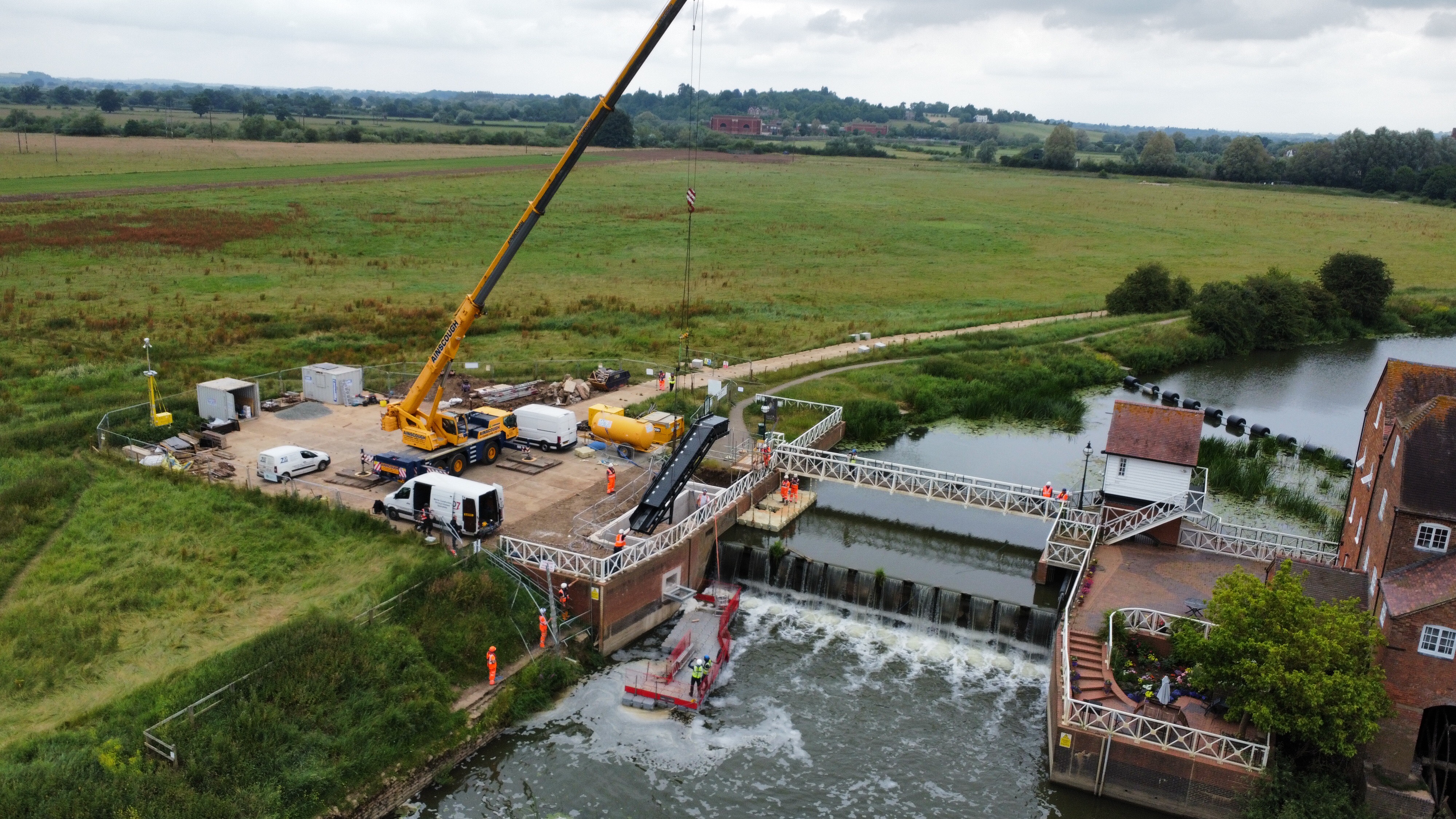
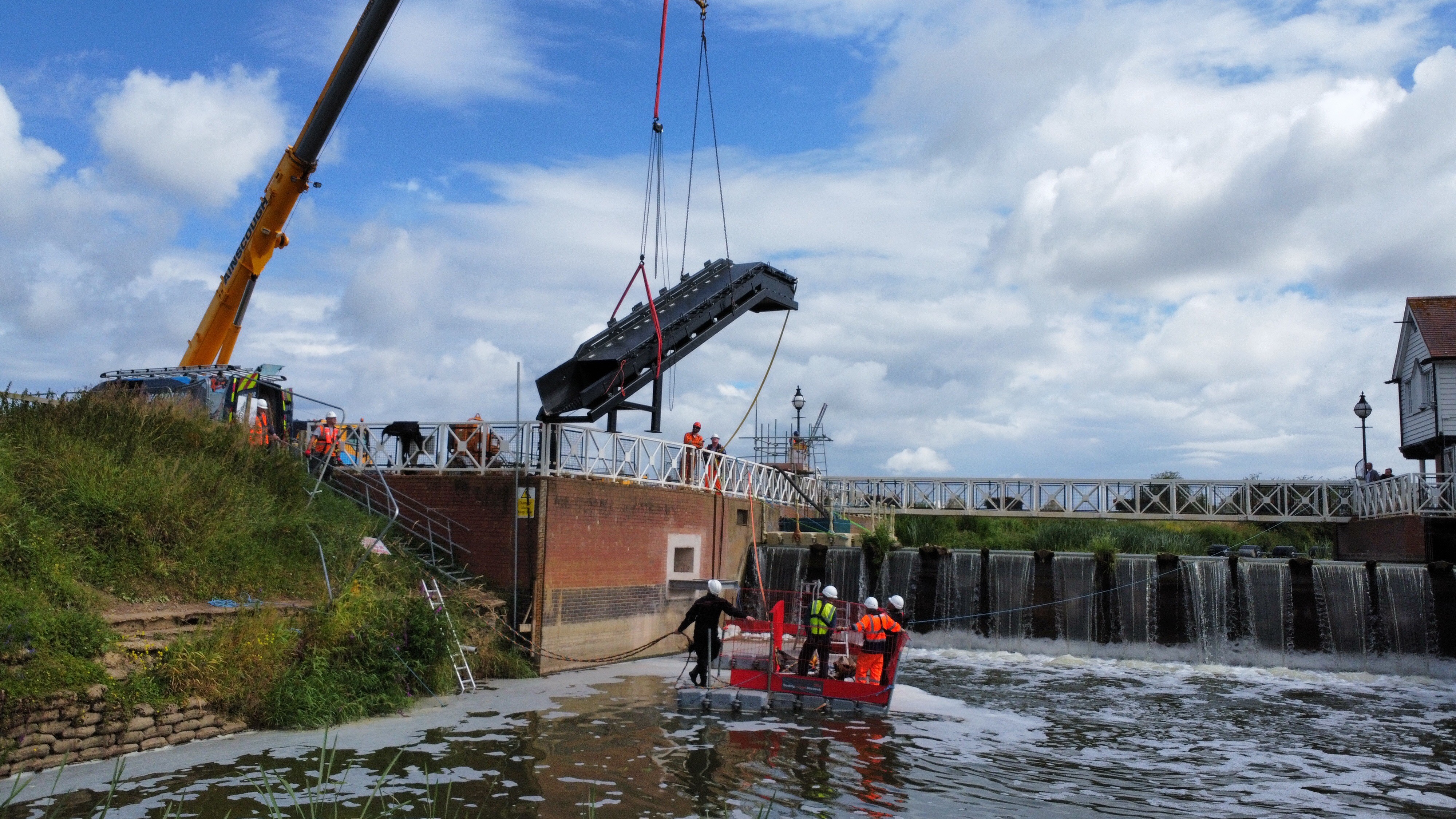
IMPORTANT UPDATE: temporary footbridge closure at Abbey Mill Wednesday 22 - Friday 24 June (during working hours). This is for safe ways of working and in line with the footpath closure notice (Footpath Closure notification ZTE 11 13 14 Order). Diversions are in place. Thank you for your patience.

There has been a lot of interest in the design - we've moved visualisation up here to help:
June's activities include:
- Formwork and reinforcement for downstream chamber
- Pour concrete for downstream chamber

Update 20 May 2022: photo of scaffold installation completion.


Update 6 May 2022: concrete pouring is almost complete. Next week we will remove formwork and shuttering from eel pass structure; backfill some of the structure and commence installation of overslung scaffolding to allow for downstream opening to be cut into the existing sluice wall.

28 April 2022:
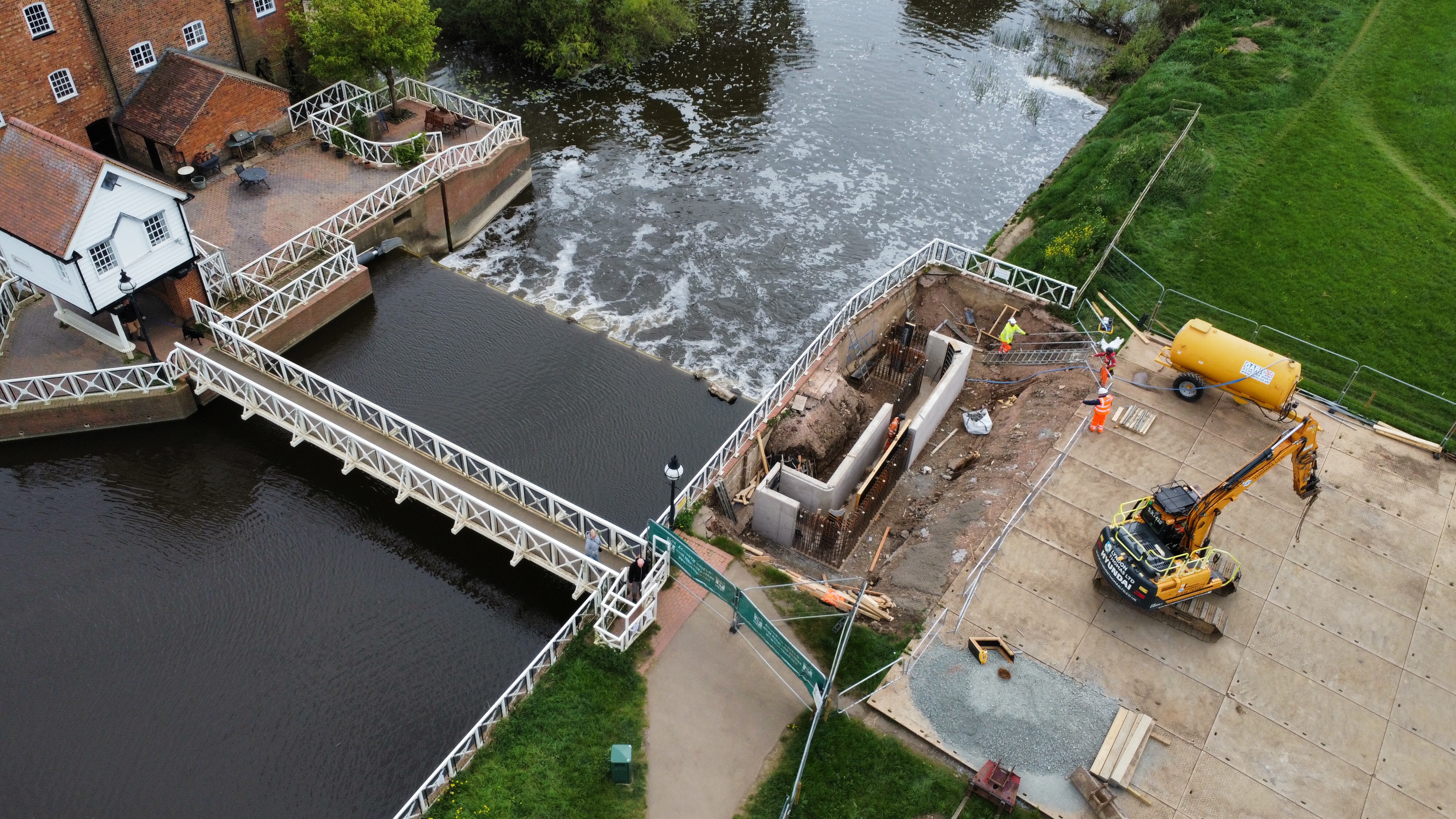 Earlier in April 2022 our contractors poured concrete for the base of the eel pass, backfilled the eel pass base and started installing reinforcement and formwork for walls of the eel pass.
Earlier in April 2022 our contractors poured concrete for the base of the eel pass, backfilled the eel pass base and started installing reinforcement and formwork for walls of the eel pass.

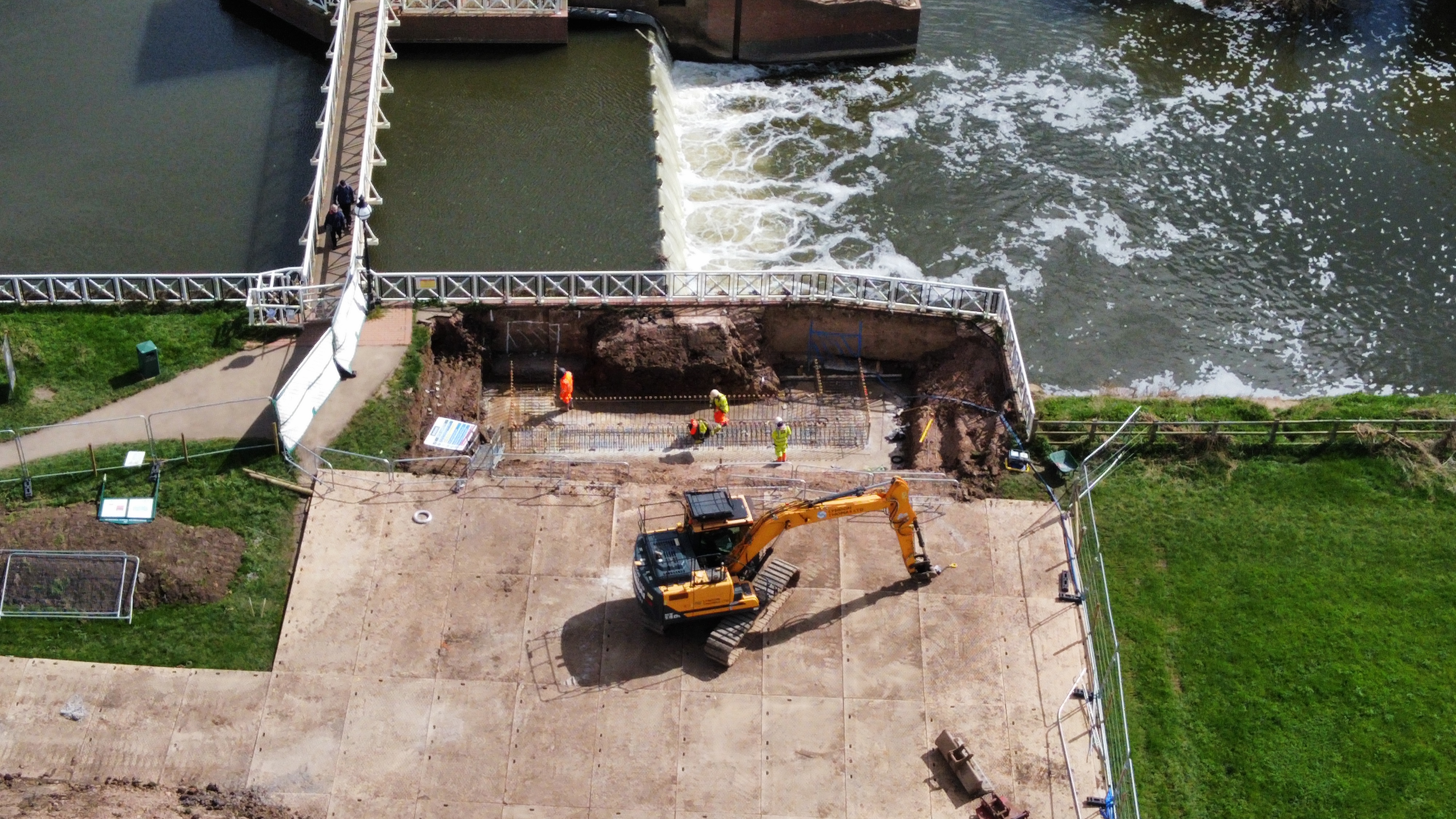
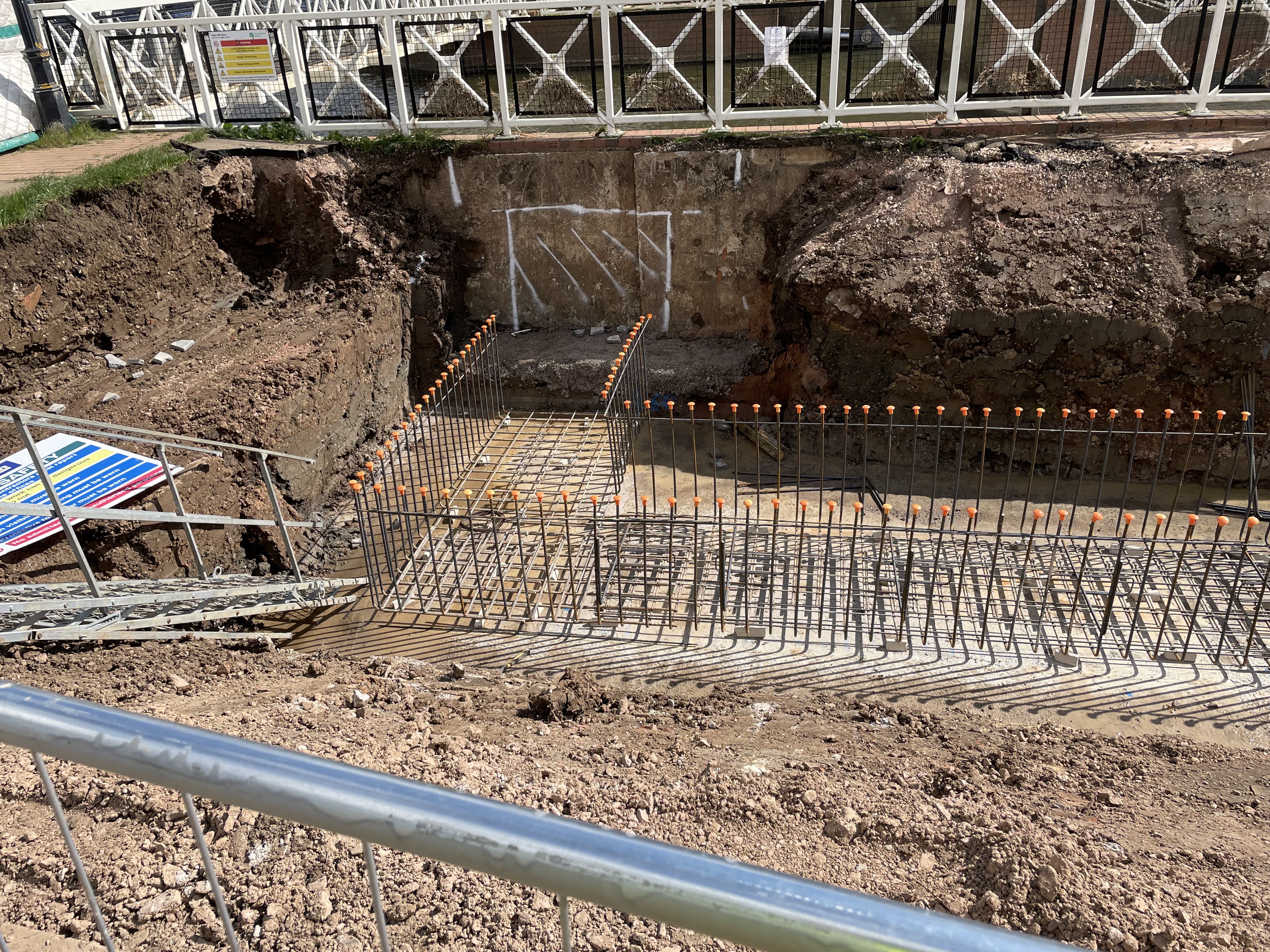
Work started in March 2022 - by the end of the month access and public crossing points were completed and excavation work began.
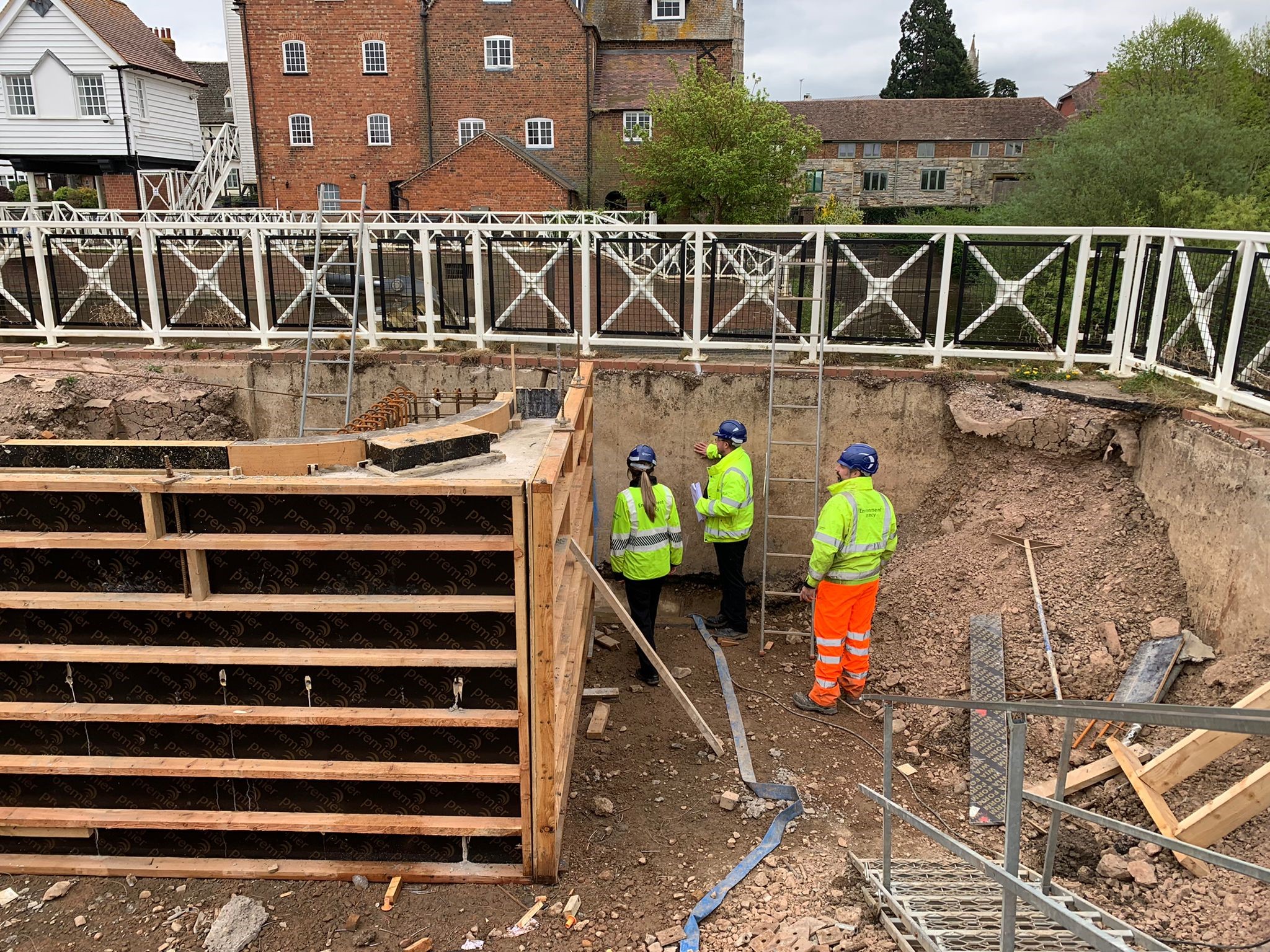
Background
The Environment Agency is addressing eel passage at two locations: Abbey Mill Sluice and Stanchard Pit Weir, on adjacent channels of the River Avon. The Environment Agency is responsible for these structures, maintaining them for navigation and river level management purposes.
Why are we doing this work?
The Environment Agency has a legal obligation to provide improved eel passage at Abbey Mill Sluice in order to comply with the Eels (England and Wales) Regulations 2009.
We are improving passage from the River Severn into the Avon catchment through the two confluences; the Mill Avon (via Abbey Mill) and Stanchard Pit to allow for migration and access in and out of the river systems in order to complete their fascinating life cycles.
As these two structures are the first obstructions to fish passage on the River Avon, this project will make a 26.7km reach of the River Avon and its tributary Carrant Brook accessible to the critically endangered European eel.
The River Severn, the Mill Avon and River Avon are migratory routes for European eel which is a protected species. Over the last 30 years, the number of juvenile eels returning to rivers has fallen by around 95% across Europe and, consequently, the International Council for the Exploration of the Sea (ICES) advises that ‘the stock of European eel is outside safe biological limits and current fisheries are not sustainable’. The amount of available habitat has decreased as a result of the construction of river barriers such as Stanchard Pit Weir and Abbey Mill Sluice. This project will positively impact on this issue by delivering effective eel passage at both sites to allow the safe migration of eels in and out of the river systems in order to complete their life cycle.
Through these works we are helping address man-made pressures on eel that offer a real chance to prevent further decline and to support recovery in the stock of eel. The Environment Agency's overall aim is to see eel fulfilling its role in the aquatic ecosystem and providing social and economic benefits from recreational and commercial fishing at sustainable levels.
Increasing connectivity for fish also supports the 2015 Severn River Basin Management Plan’s (RBMP) aim for waterbodies to achieve good ecological status or potential by 2027. It will contribute to improving the status of eel as a designated feature of the Severn Estuary Special Area of Conservation.
The image below shows the River Avon and River Severn confluence area at Tewkesbury (both rivers flow north to south in this figure) (Map courtesy of Google Earth / Infoterra Ltd and Bluesky).

Work taking place
In 2022 the Environment Agency and its contractors installed an improved eel pass near Abbey Mill Sluice as it no longer functional. (A new pass was installed by Stanchard Pit Weir in late 2021).
The redundant eel pass at Abbey Mill was a pumped system within the building, whereas the new design works using gravity (a ‘passive’ system). It will require far less maintenance and will be more effective. Construction took place from March 2022 to autumn 2022.
At Stanchard Pit the previous pass no longer functioned due to significant damage caused during high flood flows. In October 2021 it was replaced with an improved and more robust design which is also easier to maintain.
Completed pass at Stanchard Pit:
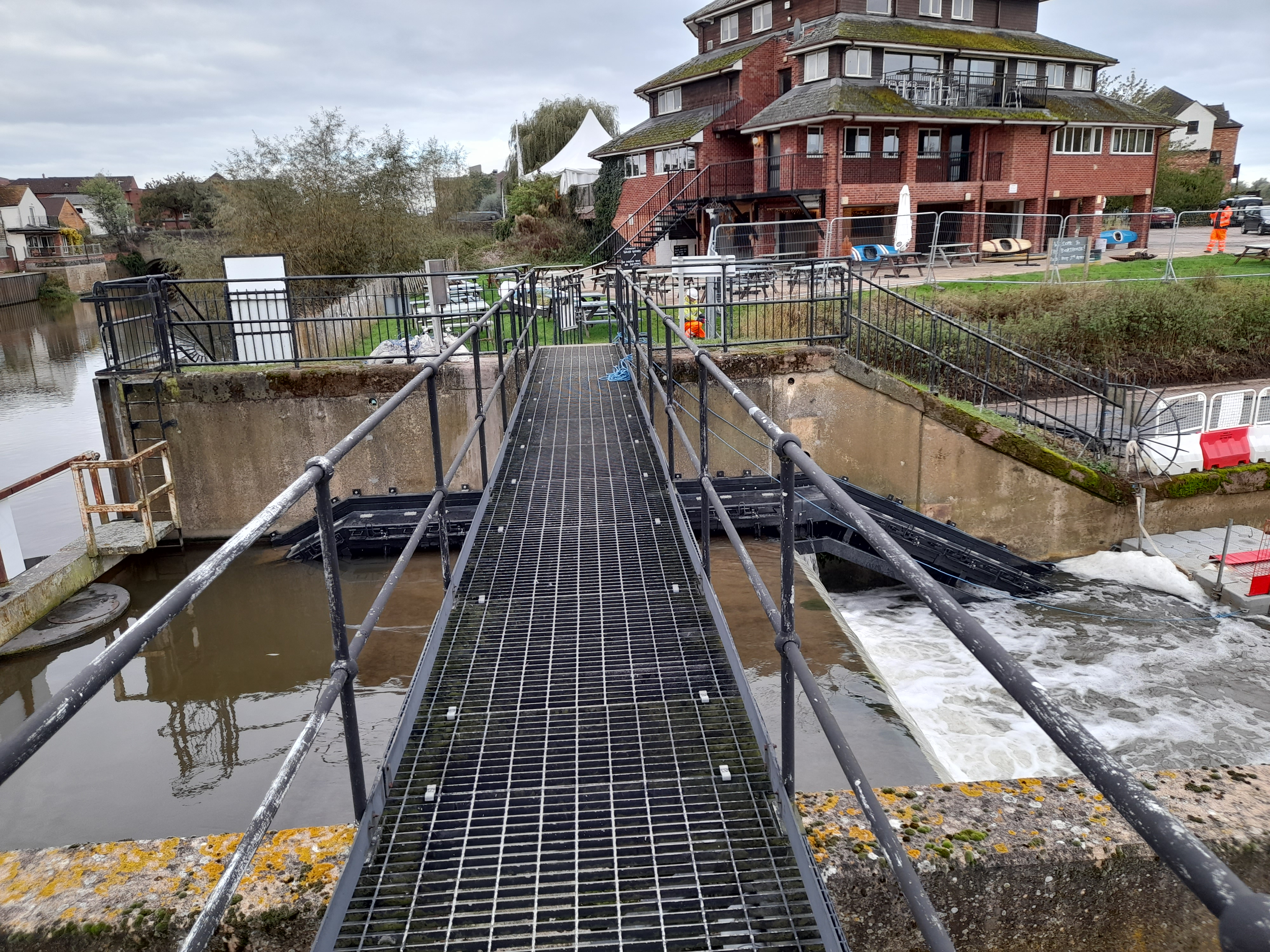
See below for more detail on the eel passes.
Construction Considerations
We liaised with the Town Council, the Severn Ham Common Land Stakeholders and Natural England.
As Abbey Mill Sluice is located close to the Grade II* listed Abbey Mill and a Scheduled Ancient Monument (Tewkesbury Abbey (St. Mary’s Abbey Church)), the pass has been carefully considered and will minimise any potential visual impact by flushing the top of the structure with the ground. We liaised with the local authority conservation officer and Historic England on matters including visual impact and were considerate of the location when developing construction plans.
The Environment Agency carried out the works as permitted development.
Access and footpath closure
The Environment Agency fully understands community concerns about visual and access disruption during construction works. Pedestrian access across the River Avon to the Severn Ham was maintained via the footbridge at Back of Avon. The Abbey Mill foot bridge was closed throughout the construction period due to its proximity to the construction works although we will keep this under review. Designated crossing points over our access track will be created to enable existing footpaths to remain in use. Map below showing closure.
Construction access at Abbey Mill was via the bridge opposite Quay Street and across the Severn Ham (shown by the red dotted line on the map below).
On behalf of the Environment Agency, our land agents Fisher German contacted several individuals and organisations regarding consent for works on the common land area of the Severn Ham (for the Abbey Mill eel pass).
Footpath closure and diversion:
Amenity considerations
The Environment Agency fully understands community concerns about visual and access disruption during any construction works.
We are legally obliged to undertake these works but appreciate the areas are popular locations for visitors and residents.
The area is close to the Severn Ham Site of Special Scientific Interest. We can reassure residents that we liaised closely with Natural England.
No trees are envisaged to be cut or removed for the installation of the proposed eel passes. Should this be needed we will consult with local authorities.
Environmental protection and improvement works are being done in collaboration with the Severn Trent Water project taking place on the Severn Ham. This is to minimise the impact and reduce the overall construction programme in delivering both projects.
The Environment Agency is committed to ensuring full restoration of the affected areas of the Severn Ham. This includes regular monitoring and any required aftercare for a period of 5 years following the end of construction works.
Ground nesting birds are being encouraged to breed in their traditional breeding areas to the south of the Ham. Monitoring has been in place since 14 February and, as a precaution, conservation dogs on leads are walking the works areas to dissuade them from nesting where they would be endangered or disturbed.
What is special about the Severn Ham and how we are we looking after it during the works?
Flood Plain Meadow: The Severn Ham is one of the last remaining traditionally managed flood meadows. This is one of the reasons it is designated as a Special Site of Scientific Interest.
This large open area is as much part of Tewkesbury`s history and heritage as the Abbey that overlooks it. It supports some uncommon and rare plants and the drastically declining Curlew.
Curlews and Skylarks with their thrilling songs are essential features of Tewkesbury`s river meadow history and heritage. They are ground-nesters so very sensitive to disturbance, especially by dogs. Sadly Lapwing and redshank no longer attempt to breed on the site. Curlew, however, despite their drastic decline and near threatened status still return the Ham.
The nationally scare Narrow-leaved water-dropwort (Oenanthe silaifolia) also known as sulphurwort, is one of the reasons the Ham is designated as a Site of Special Scientific Interest. One reason it still survives here is that the site is traditionally managed as a hay meadow and fertiliser and herbicide use is restricted. It is found damp meadows, mainly hay meadows on riverside alluvium, which receive calcareous flood-water in winter.
It still grows in a few other parts of the country but the Severn Vale is a stronghold. It is most noticeable in May when it is in full flower. It is a perennial and a plant can exist at the same spot for twenty or more years. It will also set seed which can germinate, typically near existing plants.
- The access trackway has been routed around the edge of the Ham, to avoid areas where the rare plant grows most densely. The working area has been kept to a minimum.
- We are using temporary trackmats to reduce disturbance by machinery to the soil and plants.
- We are surveying the distribution and abundance of the rare plant before and after works.
- We are committed to ensuring full restoration of the affected areas of the Severn Ham.We will be making good in a way that will enhance plant diversity
- We will over-seed the affected areas using seed harvested from local species rich meadows.
- There will be monitoring and any required aftercare for a period of 5 years following the end of construction works.
What can you do to help?
Please stick to designated or diverted public footpaths and keep dogs on leads between 1 March and 31 July.
Increased disturbance and trampling of less utilised areas of the Ham will damage the special plant communities. Any additional paths or roaming by dogs will disturb birds attempting to nest and could also ruin the haycrop. (Cutting the hay every year is essential to maintain the biodiversity of the Ham.)
Community engagement and enquiries
In Spring 2021 we engaged with stakeholders including local authorities and others involved in the Common Land access to Abbey Mill, followed by a Common Land Consent application. Our land agent also began engaging with the owner of The Boat House near Stanchard Pit.
Notices regarding the works at Abbey Mill will be displayed locally when work details are confirmed.
For enquiries about the work planned please see our contact details below (in the Get In Touch box).
The eel passes
Our preferred option is a gravity fed channel at Stanchard Pit and a gravity fed technical bypass with box eel channel at Abbey Mill.
Stanchard Pit: The eel pass comprises an aluminium channel that is lined with eel crawling media (eel tiles) fixed to the wall and over the weir structure. It is located on the left bank and provides an effective means of eel passage across the weir where flow conditions are most attractive.
Abbey Mill: The weir here is mechanised and moves during flooding so a standard channel like the one above will not work. To overcome this the upper portion of the pass is a bypass channel behind the weir wall. To minimise excavation, the lower part of the pass is formed of an aluminium box channel, similar to Stanchard Pit.
The channel will not interfere with the Abbey Mill Sluice. It will be lined with a crawling media (eel tiles) fixed to the base of the channel. There will be a debris deflector at the upstream end. This diagram can also be downloaded via the related documents section below.
What happens next
If you have any questions or concerns, please do not hesitate to contact us at:
Engagement_WestMids@environment-agency.gov.uk
For more information on how we will use and share your data, please see our Privacy Notice below and our Personal Information Charter
Audiences
- Recreational and commercial river users
- Fishing clubs and representative associations
- Members of the public with an interest in the river, the species and conservation
- Businesses
- NGOs
- Members of the public
- Elected representatives, including MPs
- Local councils
- Environment Agency customers
Interests
- Fishing and boating

Share
Share on Twitter Share on Facebook